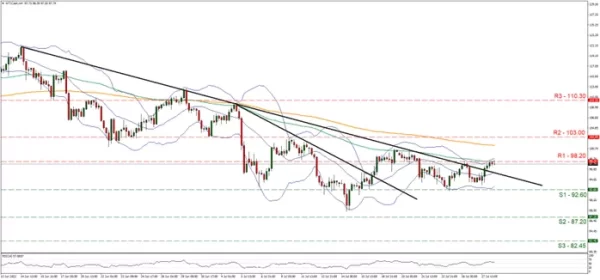Oil prices had been dropping from the 14th of June yet since the 18th of July seem to show some stabilisation. Yet let’s have a look where fundamentals are currently leading oil prices. We make a start with the weekly US oil market data. On Friday the 22nd of July the Baker Hughes oil rig count for the US showed that the active number of oil rigs remained unchanged, while on Tuesday and Wednesday respectively, both the API and EIA showed considerable drawdowns of US oil inventories for the past week. The releases tended to underscore that demand levels surpassed production, thus implying a rather tight oil market in the US which could have partially at least provided some support for oil prices.
Please note that on Wednesday we had the release of the Fed’s interest rate decision, which hiked rates by 75 basis points as was widely expected, yet Fed Chairman Powell’s press conference later on created hopes for a possible slow down for the Fed’s rate hiking path, which tended to weaken the USD. It should be noted that a weaker greenback, could make oil more attractive for the rest of the world given that the commodity is largely denominated in USDs, thus possibly increasing demand and pushing oil prices higher. Yet the overall earnings season seem to have created some optimism among market participants until now which would also support expectations for a not so gloomy global economic outlook, once again supporting the notion of increased demand for oil and allowing oil’s prices to climb higher. It will be interesting to see whether economic activity in China’s manufacturing sector has expanded at a faster pace in July, with China’s manufacturing PMI figures due out on Sunday and Monday, which would also imply increased demand for oil.
It should be noted that the US seems to be currently the top oil exporter currently, hence we would like to see the production side for the commodity from this angle. US oil producers despite the willingness to increase production and capitalize on the current high prices of the commodity, seem to find obstacles in their way. The increase of oil production despite being encouraged by the US government seems to be hindered by a lack of availability of fracking equipment. Reuters reported that demand for fracking equipment is quickly outpacing supply and thus a bottleneck is being created limiting the supply of oil. Key fracking equipment suppliers, Haliburton and Liberty Oilfield Services, warned that the market is near full utilization and new frac fleet deployment may be very difficult in the current year. Should the production side suffer from a lack of oil fracking equipment we may see the expansion of oil production slowing down, thus creating further upward pressure for oil’s price.
On the international scene we would like to note two issues, both related to Russia. The first issue we note that G7 officials are nearing a possible deal to set a price capping mechanism for Russia’s oil exports, with the timeline to be by December 5th. The price is to be made public and if actually so, we may see India and China, two of the largest global oil consumers pressing hard for a lower price regarding their imports from Russia. Yet such a low price may force Russian producers to limit production, thus pushing oil prices higher. The second issue is related to the natural gas supply cuts from Russia to Europe, which has reduced supply of Russian natural gas to the area of 20% and could increase the attractiveness for oil as an alternative thus pushing oil’s price higher. It remains to be seen to what extent all these factors will be able cause a sustainable rise of oil prices.
Technical Analysis
WTI H4
WTI’s price seems to be stabilizing for now and its price action seems to remain confined between the 98.20 (R1) and the 92.60 (S1) levels. We tend to maintain our bias for a sideways motion currently and as long as the price action remains between the prementioned levels. Also note that the RSI indicator below our 4-hour chart seems to be revolving around the reading of 50, which may also imply a rather indecisive market for now. On the other hand, slight bullish tendencies seem to be present, yet for us to switch our sideways bias in favour of a bullish outlook we would require a clear breaking of the 98.20 (R1) resistance line and for the commodity’s price action to actively start aiming or even reaching the 103.00 (R2) resistance level. On the flip side, for a bearish outlook for the commodity’s price we would require a clear breaking of the 92. 60 (S1) support line that would also signal a trend reversal and for the pair to approach the 87.20 (S2) support level.
